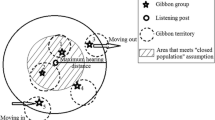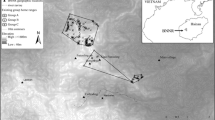Abstract
Population monitoring is very important in wildlife management and conservation. All 18 species of gibbons are considered threatened with extinction and listed on the IUCN Red List of Threatened Species. Thus, understanding and effectively monitoring their population trends and distribution are critical. Thus far, all gibbon surveying and monitoring programs have been conducted by human surveyors; this is expensive, laborious, and dependent on the surveyors’ skills. In particular, estimating group density often requires a large sample size with several skilled observers working simultaneously in the field. We used autonomous recorders to record the calls of southern yellow-cheeked crested gibbon (Nomascus gabbrielae) for at least 3 days at each of 57 posts in Nam Cat Tien sector, Cat Tien National Park, Vietnam from July to October, 2016. We extracted gibbon calls from the recordings auditorily or visually using spectrograms in RAVEN software. We detected gibbon calls at 40 recording posts during the survey. The proportion of recorders with gibbon calls in the eastern region of Nam Cat Tien sector (mean = 0.79; SE = 0.13) was higher than that in the western region (mean = 0.46; SE = 0.11). The estimated probability of occurrence in the eastern region (ψ = 0.56; SE = 0.20) was higher than that in the western region (ψ = 0.23; SE = 0.16). Passive acoustic data were useful to investigate spatial variation in the probability of occurrence of gibbon. We recommend using autonomous recorders combined with occupancy model to complement human surveyors in gibbon monitoring in areas with low gibbon density because it is efficient, low cost, and not subject to errors caused by human surveyors. In the areas of high gibbon density, absolute density estimate achieved by human surveyors might be a more suitable indicator.









Similar content being viewed by others
References
Bach, T. H., Chen, J., Hoang, M. D., Beng, K. C., & Nguyen, V. T. (2017). Feeding behavior and activity budget of the southern yellow-cheeked crested gibbons (Nomascus gabriellae) in a lowland tropical forest. American Journal of Primatology, 79(8), 1–14.
Bartlett, Q. T., Light, L., & Brockelman, W. (2015). Long-term home range use in white-handed gibbons (Hylobates lar) in Khao Yai National Park, Thailand. American Journal of Primatology, 78, 192–203.
BI & FIPI (BirdLife International & Forest Inventory and Planning Institute). (2001). Sourcebook of existing and proposed protected areas in Vietnam. Hanoi: BirdLife International Vietnam Programme and the Forest Inventory and Planning Institute.
Brockelman, W. Y., & Ali, R. (1987). Methods of surveying and sampling forest primate populations. In C. W. Marsh & R. A. Mittermeier (Eds.), Primate conservation in the tropical rainforest (pp. 23–62). New York: Alan R. Liss.
Brockelman, W. Y., & Srikosamatara, S. (1993). Estimation of density of gibbon groups by use of loud songs. American Journal of Primatology, 29(2), 93–108.
Buckland, S. T., Anderson, D. R., Burnham, K. P., & Laake, J. L. (1993). Distance sampling. Dordrecht: Springer.
Burnham, K. P., & Anderson, D. (2002). Model selection and multi-model inference: A practical information – theoretic approach (2nd ed.). New York: Springer Science+Business Media.
Campos-Cerqueira, M., & Aide, T. M. (2016). Improving distribution data of threatened species by combining acoustic monitoring and occupancy modelling. Methods in Ecology and Evolution. https://doi.org/10.1111/2041-1210X.12599.
Celis-Murillo, A., Deppe, J. L., & Ward, M. P. (2012). Effectiveness and utility of acoustic recordings for surveying tropical birds. Journal of Field Ornithology, 83, 166–179.
Chambert, T., Waddle, J. H., Miller, D. A. W., Walls, S. C., Nichols, J. D., & Yoccoz, N. (2018). A new framework for analysing automated acoustic species detection data: Occupancy estimation and optimization of recordings post-processing. Methods in Ecology and Evolution, 9(3), 560–570.
Chesmore, E. D., & Ohya, E. (2004). Automated identification of field-recorded songs of four British grasshoppers using bioacoustic signal recognition. Bulletin of Entomological Research, 94, 319–330.
Cheyne, S. M., Gilhooly, L. J., Hamard, M. C., Höing, A., Houlihan, P. J., et al (2016). Population mapping of gibbons in Kalimantan, Indonesia: Correlates of gibbon density and vegetation across the species range. Endangered Species Research, 30, 133–143.
CTNP (Cat Tien National Park). (2016). Forest cover map of Cat Tien National Park [1:10,000]. Available from http://www.namcattien.org/. Accessed 15 June 2017.
Fonzo, M. D., Collen, B., & Mace, G. M. (2013). A new method for identifying rapid decline dynamics in wild vertebrate populations. Ecology and Evolution, 3(7), 2378–2391.
Geissmann, T. (1993). Evolution of communication in gibbons (Hylobatidae). PhD dissertation, Zürich University.
Geissmann, T., & Orgeldinger, M. (2000). The relationship between duet songs and pair bonds in siamangs, Hylobates syndactylus. Animal Behavior, 60, 805–809.
Gilhooly, L. J., Rayadin, Y., & Cheyne, S. M. A. (2015). Comparison of Hylobatid survey methods using triangulation on Müller’s gibbon (Hylobates muelleri) in Sungai Wain Protection forest, East Kalimantan, Indonesia. International Journal of Primatology, 36, 567–572.
Gray, T. N. E., Phan, C., & Long, B. (2010). Modelling species distribution at multiple spatial scales: Gibbon habitat preferences in a fragmented landscape. Animal Conservation, 13, 324–332.
Hamard, M., Cheyne, S. M., & Nijman, V. (2010). Vegetation correlates of gibbon density in the peat-swamp forest of the Sabangau catchment, Central Kalimantan, Indonesia. American Journal of Primatology, 72(7), 607–616.
Hilje, B., & Aide, T. M. (2012). Calling activity of the common tink frog (Diasporus diastema) (Eleutherodactylidae) in secondary forests of the Caribbean of Costa Rica. Tropical Conservation Science, 5, 25–37.
IUCN Red List of Threatened Species (2017). Version 2017–1. www.iucnredlist.org.
Jiang, X. L., Luo, Z. H., & Zhao, S. Y. (2006). Status and distribution patterns of black crested gibbon (Nomascus concolor jingdongensis) in Wulian Mountains, Yunnan, China: Implications for conservation. Primates, 47, 264–271.
Kalan, A. K., Mundry, R., Wagner, O. J. J., Heinicke, S., Boesch, C., & Kühl, H. S. (2015). Towards the automated detection and occupancy estimation of primates using passive acoustic monitoring. Ecological Indicators, 54, 217–226.
Kenyon, M. A. (2008). Ecology of the golden-cheeked gibbon (Nomascus gabriellae) in Cat Tien National Park, Vietnam. PhD dissertation, University of Cambridge.
Kidney, D., Rawson, B. M., Borchers, D. L., Stevenson, B. C., Marques, T. A., & Thomas, L. (2016). An efficient acoustic density estimation method with human detectors applied to gibbons in Cambodia. PLoS One, 11(5), e0155066.
MacKenzie, D. I., Nichols, J. D., Royle, J. A., Pollock, K. H., Bailey, L. L., & Hines, J. E. (2006). Occupancy estimation and modeling: Inferring patterns and dynamics of species occurrence. New York: Academic Press.
Marsh, D. M., & Trenham, P. C. (2008). Tracking current trends in plant and animal population monitoring. Conservation Biology, 22, 647–655.
Nijman, V. (2004). Conservation of the Javan gibbon Hylobates moloch: Population estimates, local extinctions and conservation priorities. The Raffles Bulletin of Zoology, 52, 271–280.
O’Brien, T. G., Kinnaird, M. F., Nurcahyo, A., Iqbal, M., & Rusmanto, M. (2004). Abundance and distribution of sympatric gibbons in a threatened Sumatran rain forest. International Journal of Primatology, 25, 267–284.
Phoonjampa, R., Koenig, A., Brockelman, W. Y., Borries, C., Gale, G. A., et al (2011). Pileated gibbon density in relation to habitat characteristics and post-logging forest recovery. Biotropica, 43(5), 619–627.
Reisland, M. A., & Lambert, J. E. (2016). Sympatric apes in sacred forests: Shared space and habitat use by humans and endangered Javan gibbons (Hylobates moloch). PLoS One, 11(1), e0146891.
Spillmann, B., Noordwijk, V., Erik, M. A., Willems, E. P., Setia, T. M., et al (2015). Validation of an acoustic location system to monitor Bornean orangutan (Pongo pygmaeus wurmbii) long calls. American Journal of Primatology, 77(7), 767–776.
Thomas, L., & Marques, T. (2012). Passive acoustic monitoring for estimating animal density. Acoustics Today, 8, 35–44.
Thompson, M. E., Schwager, S. J., Payne, K. B., & Turkalo, A. K. (2010). Acoustic estimation of wildlife abundance: Methodology for vocal mammals in forested habitats. African Journal of Ecology, 48(3), 654–661.
Thompson, W. L., White, G. C., & Gowan, C. (1998). Monitoring vertebrate populations. New York: Academic Press.
Tremain, S. B., Swiston, K. A., & Mennill, D. J. (2008). Seasonal variation in acoustic signals of pileated woodpeckers (Dryocopus pileatus). Wilson Journal of Ornithology, 120, 499–504.
Vu, T. T., & Dong, T. H. (2015). Estimation of northern yellow-cheeked gibbon (Nomascus annamensis) population size in Kon Cha Rang Nature Reserve: A new method–using a weighted correction factor. Vietnamese Journal of Primatology, 2, 41–48.
Vu, T. T., Tran, V. D., Giang, T. T., Nguyen, H. V., Nguyen, D. M., et al (2016). A mark-recapture population size estimation of southern yellow-cheeked crested gibbon Nomascus gabriellae (Thomas, 1909) in Chu Yang Sin National Park, Vietnam. Asian Primate Journal, 6, 33–42.
Vu, T. T., Tran, M. L., Nguyen, D. M., Tran, V. D., Doherty, P. F., et al. (2018a). A distance sampling approach to estimate density and abundance of gibbon groups. American Journal of Primatology, 80(9), 1–7. https://doi.org/10.1002/ajp.22903
Vu, T. T., Tran, M. L., Nguyen, D. M., Tran, V. D., & Ta, T. N. (2018b). Improving the estimation of calling probability and correction factors in gibbon monitoring using the auditory point count method. International Journal of Primatology, 39(2), 222–236.
White, G. C., & Burnham, K. P. (1999). Program MARK: Survival estimation from populations of marked animals. Bird Study, 46, 120–139.
Williams, B., Nichols, J., & Conroy, M. (2002). Analysis and management of animal populations. Cambridge, UK: Academic Press.
Yoccoz, N. G., Nichols, J. D., & Boulinier, T. (2011). Monitoring of biological diversity in space and time. Trends in Ecology and Evolution, 16(8), 446–453.
Zwart, M. C., Baker, A., McGowan, P. J. K., & Whittingham, M. J. (2014). The use of automated bioacoustic recorders to replace human wildlife surveys: An example using nightjars. PLoS One, 9(7), 1–8.
Acknowledgments
We would like to thank the Vietnam National Foundation for Science and Technology (NAFOSTED) for support given to this project (Grant number 106-NN.06-2015.37). Our gratitude also extends to the forest rangers in Cat Tien National Park for permitting us to conduct the survey. I would also like to thank all the field assistants for helping us with the field survey. We are thankful to Dr. Janice Moore at Colorado State University and Dr. Greg Nagle for help with proofreading of the manuscript. Finally, we thank the reviewers and editors for their insightful comments, suggestions, and corrections.
Author information
Authors and Affiliations
Corresponding author
Additional information
Handling Editor: Joanna M. Setchell
Rights and permissions
About this article
Cite this article
Vu, T.T., Tran, L.M. An Application of Autonomous Recorders for Gibbon Monitoring. Int J Primatol 40, 169–186 (2019). https://doi.org/10.1007/s10764-018-0073-3
Received:
Accepted:
Published:
Issue Date:
DOI: https://doi.org/10.1007/s10764-018-0073-3




